GIT201 Essay: Robotics and AI Trends in Tourism & Hospitality
VerifiedAdded on 2022/10/17
|10
|2387
|9
Essay
AI Summary
This essay delves into the significant trend of robotics within the tourism and hospitality industries. It identifies key factors driving this trend, such as catering to millennials and the increasing emphasis on seamless technology, while also providing a brief history of robotics. The essay explores the integration of Artificial Intelligence (AI) with robotics, highlighting context-specific applications like robotic suitcases, chatbots for bookings, and security robots in airports. It assesses the positive impacts of these technologies, including improved guest experiences and operational efficiencies, as well as the use of AI for data analysis and augmented/virtual reality applications. Furthermore, the essay presents real-life examples like Alibaba A.I. Labs' delivery robots and discusses how robotics can save labor costs and improve service delivery. However, it also acknowledges and critically assesses criticisms, such as potential job displacement, high initial investment costs, and the limitations of robotic capabilities, as well as issues related to privacy concerns with drones. The essay concludes by mentioning the challenges and hesitations in implementing robotics within the tourism industry.

Running Head: GLOBAL INNOVATIONS AND TRENDS
GLOBAL INNOVATIONS AND TRENDS
Name of the Student
Name of the University
Author Note
GLOBAL INNOVATIONS AND TRENDS
Name of the Student
Name of the University
Author Note
Paraphrase This Document
Need a fresh take? Get an instant paraphrase of this document with our AI Paraphraser
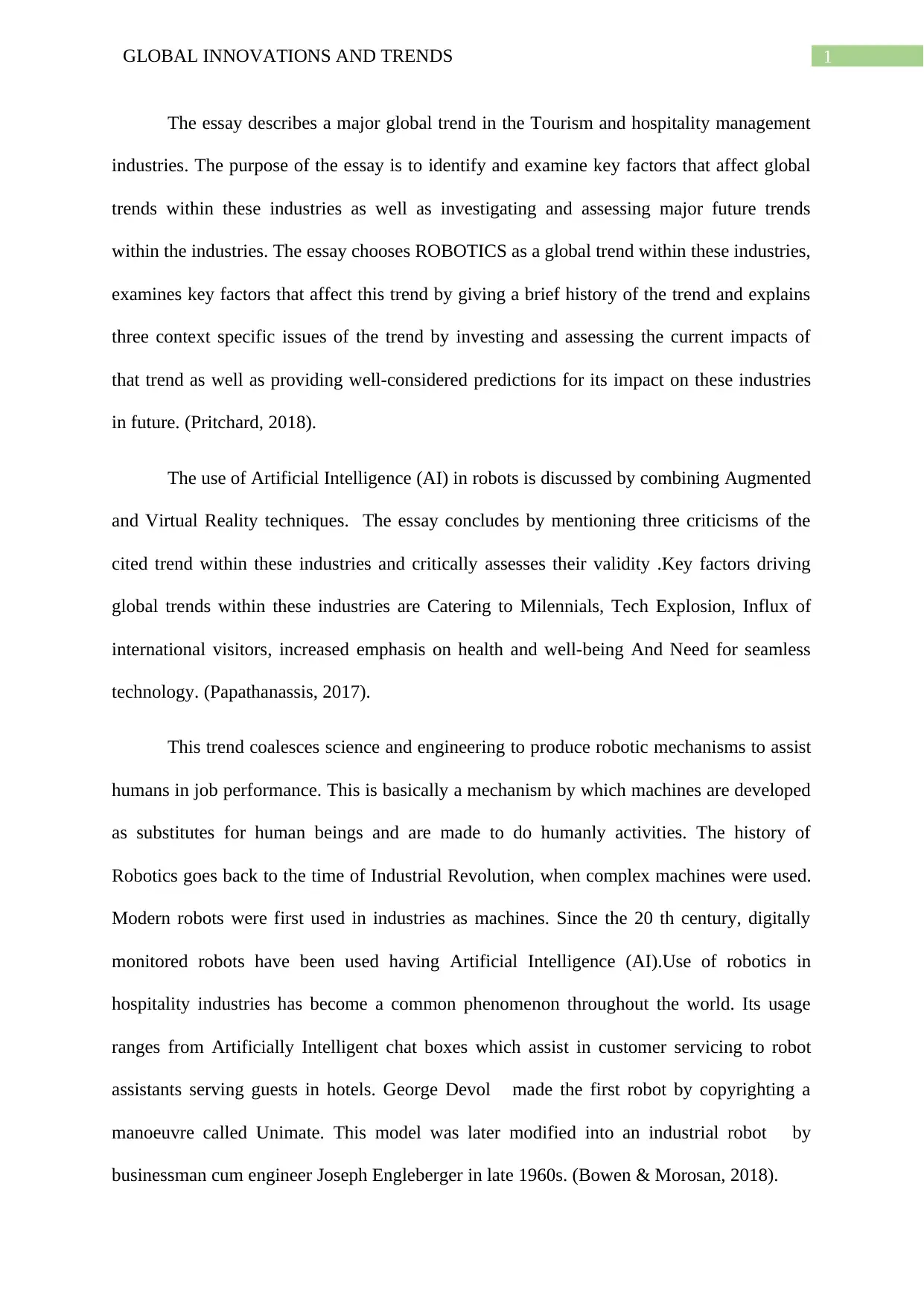
1GLOBAL INNOVATIONS AND TRENDS
The essay describes a major global trend in the Tourism and hospitality management
industries. The purpose of the essay is to identify and examine key factors that affect global
trends within these industries as well as investigating and assessing major future trends
within the industries. The essay chooses ROBOTICS as a global trend within these industries,
examines key factors that affect this trend by giving a brief history of the trend and explains
three context specific issues of the trend by investing and assessing the current impacts of
that trend as well as providing well-considered predictions for its impact on these industries
in future. (Pritchard, 2018).
The use of Artificial Intelligence (AI) in robots is discussed by combining Augmented
and Virtual Reality techniques. The essay concludes by mentioning three criticisms of the
cited trend within these industries and critically assesses their validity .Key factors driving
global trends within these industries are Catering to Milennials, Tech Explosion, Influx of
international visitors, increased emphasis on health and well-being And Need for seamless
technology. (Papathanassis, 2017).
This trend coalesces science and engineering to produce robotic mechanisms to assist
humans in job performance. This is basically a mechanism by which machines are developed
as substitutes for human beings and are made to do humanly activities. The history of
Robotics goes back to the time of Industrial Revolution, when complex machines were used.
Modern robots were first used in industries as machines. Since the 20 th century, digitally
monitored robots have been used having Artificial Intelligence (AI).Use of robotics in
hospitality industries has become a common phenomenon throughout the world. Its usage
ranges from Artificially Intelligent chat boxes which assist in customer servicing to robot
assistants serving guests in hotels. George Devol made the first robot by copyrighting a
manoeuvre called Unimate. This model was later modified into an industrial robot by
businessman cum engineer Joseph Engleberger in late 1960s. (Bowen & Morosan, 2018).
The essay describes a major global trend in the Tourism and hospitality management
industries. The purpose of the essay is to identify and examine key factors that affect global
trends within these industries as well as investigating and assessing major future trends
within the industries. The essay chooses ROBOTICS as a global trend within these industries,
examines key factors that affect this trend by giving a brief history of the trend and explains
three context specific issues of the trend by investing and assessing the current impacts of
that trend as well as providing well-considered predictions for its impact on these industries
in future. (Pritchard, 2018).
The use of Artificial Intelligence (AI) in robots is discussed by combining Augmented
and Virtual Reality techniques. The essay concludes by mentioning three criticisms of the
cited trend within these industries and critically assesses their validity .Key factors driving
global trends within these industries are Catering to Milennials, Tech Explosion, Influx of
international visitors, increased emphasis on health and well-being And Need for seamless
technology. (Papathanassis, 2017).
This trend coalesces science and engineering to produce robotic mechanisms to assist
humans in job performance. This is basically a mechanism by which machines are developed
as substitutes for human beings and are made to do humanly activities. The history of
Robotics goes back to the time of Industrial Revolution, when complex machines were used.
Modern robots were first used in industries as machines. Since the 20 th century, digitally
monitored robots have been used having Artificial Intelligence (AI).Use of robotics in
hospitality industries has become a common phenomenon throughout the world. Its usage
ranges from Artificially Intelligent chat boxes which assist in customer servicing to robot
assistants serving guests in hotels. George Devol made the first robot by copyrighting a
manoeuvre called Unimate. This model was later modified into an industrial robot by
businessman cum engineer Joseph Engleberger in late 1960s. (Bowen & Morosan, 2018).

2GLOBAL INNOVATIONS AND TRENDS
Robotics is being used to a large extent in Hospitality and Tourism industries .The
essay describes three context specific uses of Robots in these industries. Firstly, in hotels
and hospitals , people often use a moving object as suitcase while travelling. This is the
specific use of a robotic suitcase called TRAVELMATE that follows the user on its own.
Making use of anti-collision technology, it can turn a full circle and eliminates the worries of
being carried or pushed .Secondly, flights and hotels can be booked by using ROBOTIC
CHATBOTS. As a chatbot is a type of software conducting visual , audio or text
conversations between people , these robotic applications can deliver basic customer
services by intelligently guiding customers through the booking process. Thirdly, deploying
robots for the security of airports is a major technological innovation. ( Hsu, 2018). These
SECURITY ROBOTS can provide excellent service by identifying concealed weapons and
helping to provide safety and peace of mind to passengers while travelling.The impacts of
employing robots as illustrated above are proving beneficial to the hospitality and tourism
industries. Robots in hospitality industry improves the overall experience of guests, as
information can be provided at the touch of a button .Check-ins and Check-outs have been
made easier by robotic assistance. Another use of AI using robots in Hospitality is Data
Analysis in which robotic technology can be used to sort data through surveys and online
reviews .AI can then analyse this information to conclude about the overall performance of
the industry .( Murphya, Hofackerb & Gretzelc, 2016). Robots can apply AI in Hospitality
industries to improve human-robot communication by using Augmented Reality
(AR).Medical robots facilitated with Augmented Reality can help to reshape the future of
disabled persons. Robots can be used in healthcare by performing delicate surgeries as well
as providing direct assistance to patients .Using Virtual Reality trains robots to identify
objects. This technique can be applied in hospitals to teach robots the finest biological
structures in the human body. Robots can respond to customer needs and answer them
Robotics is being used to a large extent in Hospitality and Tourism industries .The
essay describes three context specific uses of Robots in these industries. Firstly, in hotels
and hospitals , people often use a moving object as suitcase while travelling. This is the
specific use of a robotic suitcase called TRAVELMATE that follows the user on its own.
Making use of anti-collision technology, it can turn a full circle and eliminates the worries of
being carried or pushed .Secondly, flights and hotels can be booked by using ROBOTIC
CHATBOTS. As a chatbot is a type of software conducting visual , audio or text
conversations between people , these robotic applications can deliver basic customer
services by intelligently guiding customers through the booking process. Thirdly, deploying
robots for the security of airports is a major technological innovation. ( Hsu, 2018). These
SECURITY ROBOTS can provide excellent service by identifying concealed weapons and
helping to provide safety and peace of mind to passengers while travelling.The impacts of
employing robots as illustrated above are proving beneficial to the hospitality and tourism
industries. Robots in hospitality industry improves the overall experience of guests, as
information can be provided at the touch of a button .Check-ins and Check-outs have been
made easier by robotic assistance. Another use of AI using robots in Hospitality is Data
Analysis in which robotic technology can be used to sort data through surveys and online
reviews .AI can then analyse this information to conclude about the overall performance of
the industry .( Murphya, Hofackerb & Gretzelc, 2016). Robots can apply AI in Hospitality
industries to improve human-robot communication by using Augmented Reality
(AR).Medical robots facilitated with Augmented Reality can help to reshape the future of
disabled persons. Robots can be used in healthcare by performing delicate surgeries as well
as providing direct assistance to patients .Using Virtual Reality trains robots to identify
objects. This technique can be applied in hospitals to teach robots the finest biological
structures in the human body. Robots can respond to customer needs and answer them
⊘ This is a preview!⊘
Do you want full access?
Subscribe today to unlock all pages.

Trusted by 1+ million students worldwide
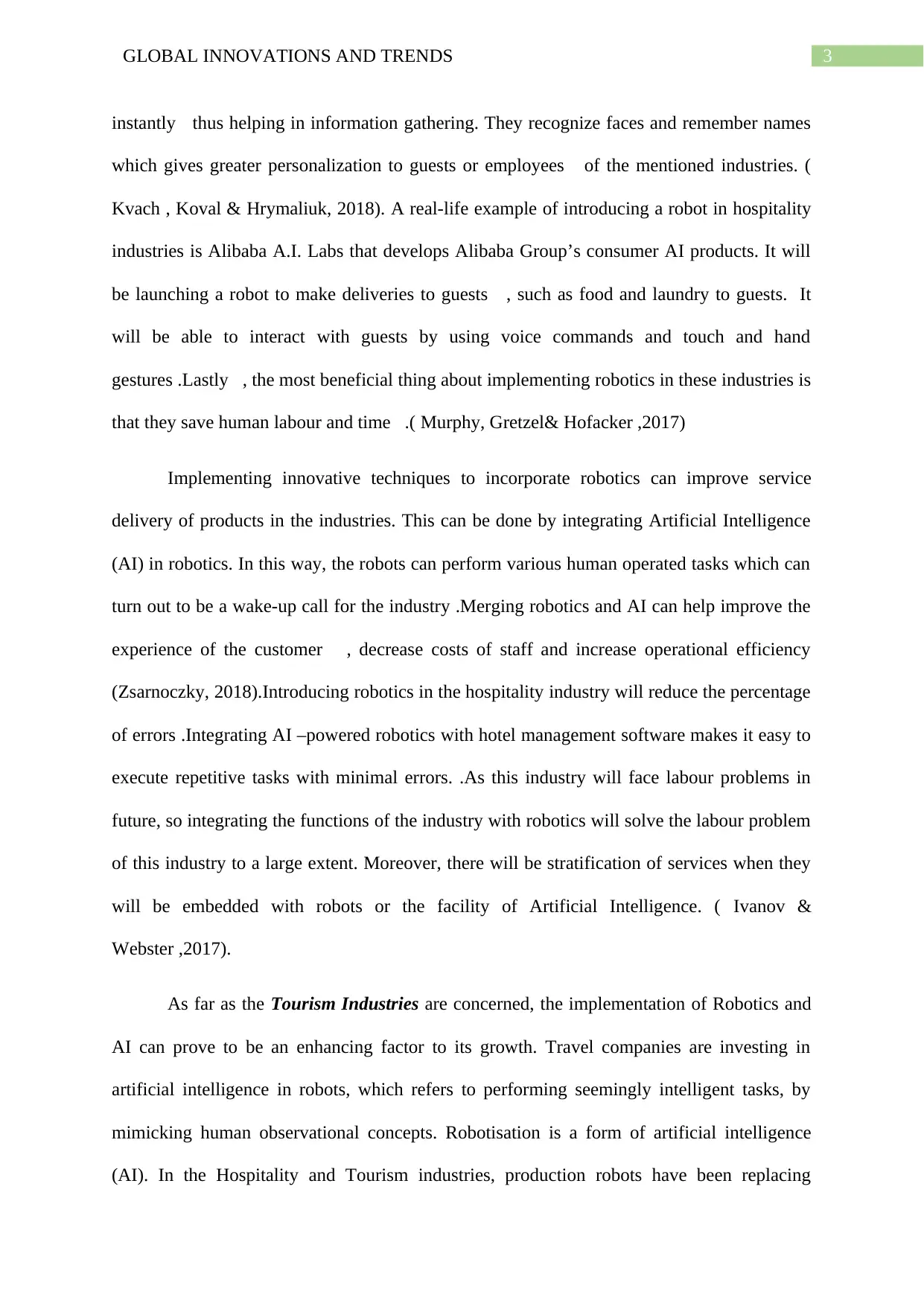
3GLOBAL INNOVATIONS AND TRENDS
instantly thus helping in information gathering. They recognize faces and remember names
which gives greater personalization to guests or employees of the mentioned industries. (
Kvach , Koval & Hrymaliuk, 2018). A real-life example of introducing a robot in hospitality
industries is Alibaba A.I. Labs that develops Alibaba Group’s consumer AI products. It will
be launching a robot to make deliveries to guests , such as food and laundry to guests. It
will be able to interact with guests by using voice commands and touch and hand
gestures .Lastly , the most beneficial thing about implementing robotics in these industries is
that they save human labour and time .( Murphy, Gretzel& Hofacker ,2017)
Implementing innovative techniques to incorporate robotics can improve service
delivery of products in the industries. This can be done by integrating Artificial Intelligence
(AI) in robotics. In this way, the robots can perform various human operated tasks which can
turn out to be a wake-up call for the industry .Merging robotics and AI can help improve the
experience of the customer , decrease costs of staff and increase operational efficiency
(Zsarnoczky, 2018).Introducing robotics in the hospitality industry will reduce the percentage
of errors .Integrating AI –powered robotics with hotel management software makes it easy to
execute repetitive tasks with minimal errors. .As this industry will face labour problems in
future, so integrating the functions of the industry with robotics will solve the labour problem
of this industry to a large extent. Moreover, there will be stratification of services when they
will be embedded with robots or the facility of Artificial Intelligence. ( Ivanov &
Webster ,2017).
As far as the Tourism Industries are concerned, the implementation of Robotics and
AI can prove to be an enhancing factor to its growth. Travel companies are investing in
artificial intelligence in robots, which refers to performing seemingly intelligent tasks, by
mimicking human observational concepts. Robotisation is a form of artificial intelligence
(AI). In the Hospitality and Tourism industries, production robots have been replacing
instantly thus helping in information gathering. They recognize faces and remember names
which gives greater personalization to guests or employees of the mentioned industries. (
Kvach , Koval & Hrymaliuk, 2018). A real-life example of introducing a robot in hospitality
industries is Alibaba A.I. Labs that develops Alibaba Group’s consumer AI products. It will
be launching a robot to make deliveries to guests , such as food and laundry to guests. It
will be able to interact with guests by using voice commands and touch and hand
gestures .Lastly , the most beneficial thing about implementing robotics in these industries is
that they save human labour and time .( Murphy, Gretzel& Hofacker ,2017)
Implementing innovative techniques to incorporate robotics can improve service
delivery of products in the industries. This can be done by integrating Artificial Intelligence
(AI) in robotics. In this way, the robots can perform various human operated tasks which can
turn out to be a wake-up call for the industry .Merging robotics and AI can help improve the
experience of the customer , decrease costs of staff and increase operational efficiency
(Zsarnoczky, 2018).Introducing robotics in the hospitality industry will reduce the percentage
of errors .Integrating AI –powered robotics with hotel management software makes it easy to
execute repetitive tasks with minimal errors. .As this industry will face labour problems in
future, so integrating the functions of the industry with robotics will solve the labour problem
of this industry to a large extent. Moreover, there will be stratification of services when they
will be embedded with robots or the facility of Artificial Intelligence. ( Ivanov &
Webster ,2017).
As far as the Tourism Industries are concerned, the implementation of Robotics and
AI can prove to be an enhancing factor to its growth. Travel companies are investing in
artificial intelligence in robots, which refers to performing seemingly intelligent tasks, by
mimicking human observational concepts. Robotisation is a form of artificial intelligence
(AI). In the Hospitality and Tourism industries, production robots have been replacing
Paraphrase This Document
Need a fresh take? Get an instant paraphrase of this document with our AI Paraphraser
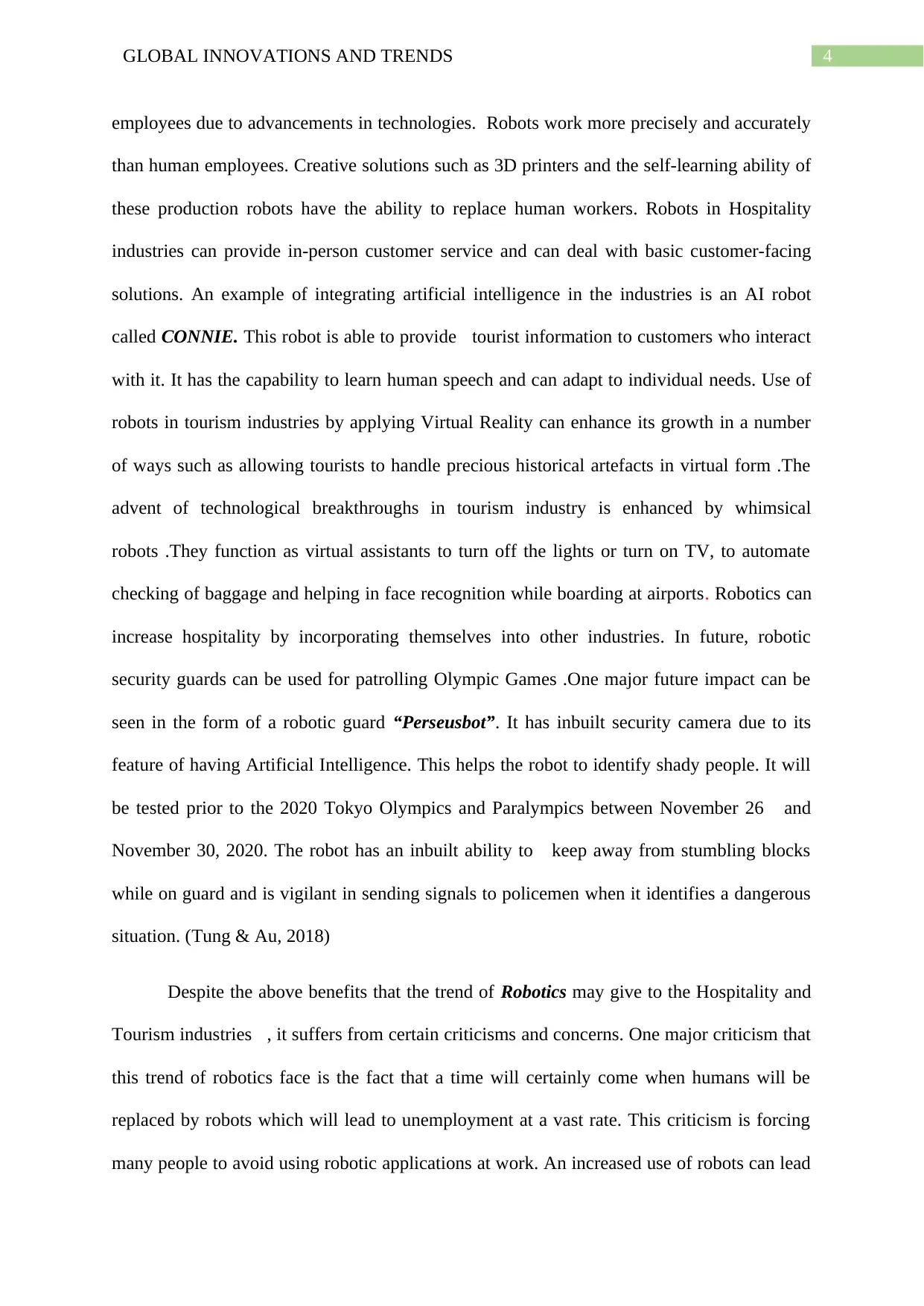
4GLOBAL INNOVATIONS AND TRENDS
employees due to advancements in technologies. Robots work more precisely and accurately
than human employees. Creative solutions such as 3D printers and the self-learning ability of
these production robots have the ability to replace human workers. Robots in Hospitality
industries can provide in-person customer service and can deal with basic customer-facing
solutions. An example of integrating artificial intelligence in the industries is an AI robot
called CONNIE. This robot is able to provide tourist information to customers who interact
with it. It has the capability to learn human speech and can adapt to individual needs. Use of
robots in tourism industries by applying Virtual Reality can enhance its growth in a number
of ways such as allowing tourists to handle precious historical artefacts in virtual form .The
advent of technological breakthroughs in tourism industry is enhanced by whimsical
robots .They function as virtual assistants to turn off the lights or turn on TV, to automate
checking of baggage and helping in face recognition while boarding at airports. Robotics can
increase hospitality by incorporating themselves into other industries. In future, robotic
security guards can be used for patrolling Olympic Games .One major future impact can be
seen in the form of a robotic guard “Perseusbot”. It has inbuilt security camera due to its
feature of having Artificial Intelligence. This helps the robot to identify shady people. It will
be tested prior to the 2020 Tokyo Olympics and Paralympics between November 26 and
November 30, 2020. The robot has an inbuilt ability to keep away from stumbling blocks
while on guard and is vigilant in sending signals to policemen when it identifies a dangerous
situation. (Tung & Au, 2018)
Despite the above benefits that the trend of Robotics may give to the Hospitality and
Tourism industries , it suffers from certain criticisms and concerns. One major criticism that
this trend of robotics face is the fact that a time will certainly come when humans will be
replaced by robots which will lead to unemployment at a vast rate. This criticism is forcing
many people to avoid using robotic applications at work. An increased use of robots can lead
employees due to advancements in technologies. Robots work more precisely and accurately
than human employees. Creative solutions such as 3D printers and the self-learning ability of
these production robots have the ability to replace human workers. Robots in Hospitality
industries can provide in-person customer service and can deal with basic customer-facing
solutions. An example of integrating artificial intelligence in the industries is an AI robot
called CONNIE. This robot is able to provide tourist information to customers who interact
with it. It has the capability to learn human speech and can adapt to individual needs. Use of
robots in tourism industries by applying Virtual Reality can enhance its growth in a number
of ways such as allowing tourists to handle precious historical artefacts in virtual form .The
advent of technological breakthroughs in tourism industry is enhanced by whimsical
robots .They function as virtual assistants to turn off the lights or turn on TV, to automate
checking of baggage and helping in face recognition while boarding at airports. Robotics can
increase hospitality by incorporating themselves into other industries. In future, robotic
security guards can be used for patrolling Olympic Games .One major future impact can be
seen in the form of a robotic guard “Perseusbot”. It has inbuilt security camera due to its
feature of having Artificial Intelligence. This helps the robot to identify shady people. It will
be tested prior to the 2020 Tokyo Olympics and Paralympics between November 26 and
November 30, 2020. The robot has an inbuilt ability to keep away from stumbling blocks
while on guard and is vigilant in sending signals to policemen when it identifies a dangerous
situation. (Tung & Au, 2018)
Despite the above benefits that the trend of Robotics may give to the Hospitality and
Tourism industries , it suffers from certain criticisms and concerns. One major criticism that
this trend of robotics face is the fact that a time will certainly come when humans will be
replaced by robots which will lead to unemployment at a vast rate. This criticism is forcing
many people to avoid using robotic applications at work. An increased use of robots can lead
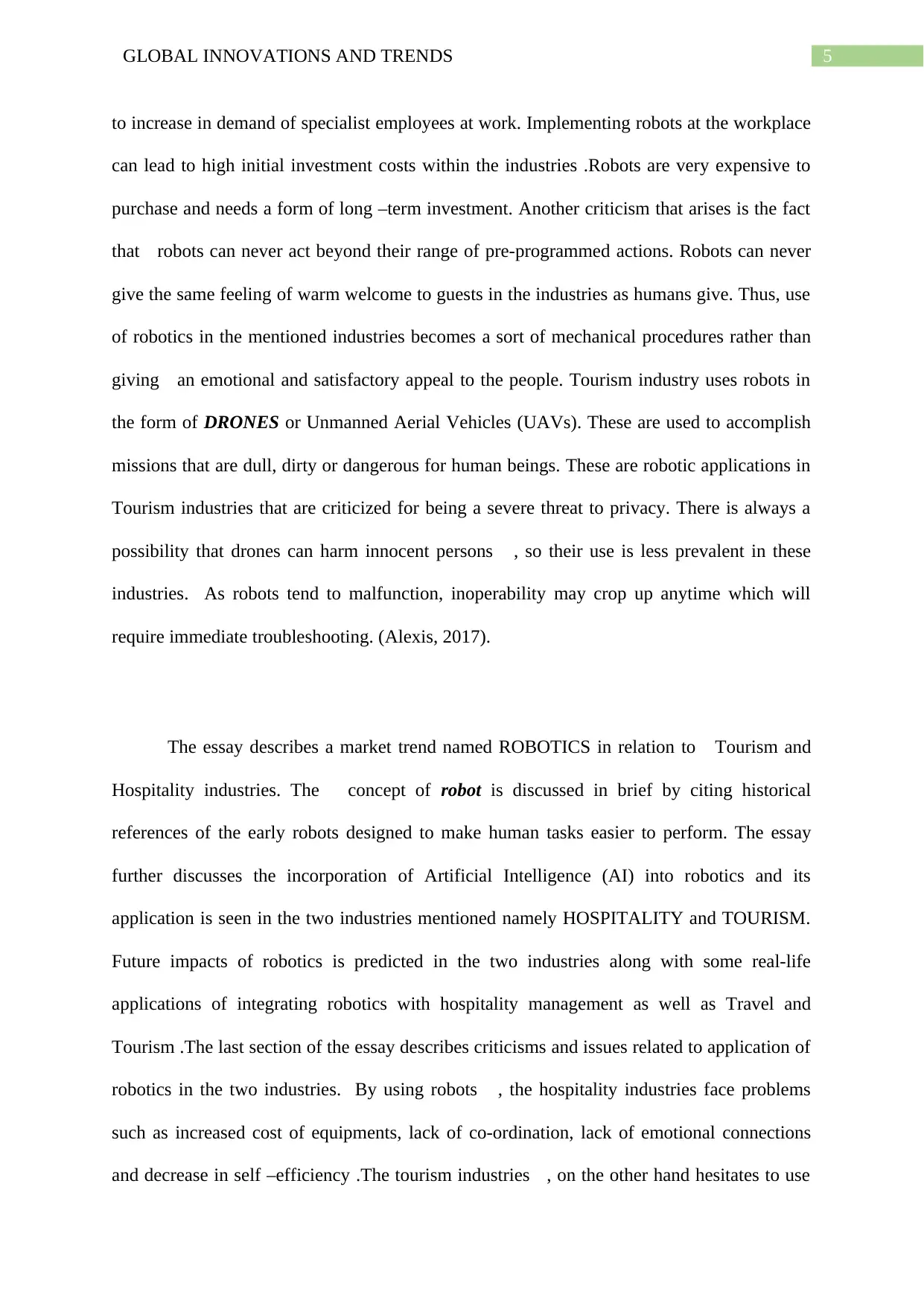
5GLOBAL INNOVATIONS AND TRENDS
to increase in demand of specialist employees at work. Implementing robots at the workplace
can lead to high initial investment costs within the industries .Robots are very expensive to
purchase and needs a form of long –term investment. Another criticism that arises is the fact
that robots can never act beyond their range of pre-programmed actions. Robots can never
give the same feeling of warm welcome to guests in the industries as humans give. Thus, use
of robotics in the mentioned industries becomes a sort of mechanical procedures rather than
giving an emotional and satisfactory appeal to the people. Tourism industry uses robots in
the form of DRONES or Unmanned Aerial Vehicles (UAVs). These are used to accomplish
missions that are dull, dirty or dangerous for human beings. These are robotic applications in
Tourism industries that are criticized for being a severe threat to privacy. There is always a
possibility that drones can harm innocent persons , so their use is less prevalent in these
industries. As robots tend to malfunction, inoperability may crop up anytime which will
require immediate troubleshooting. (Alexis, 2017).
The essay describes a market trend named ROBOTICS in relation to Tourism and
Hospitality industries. The concept of robot is discussed in brief by citing historical
references of the early robots designed to make human tasks easier to perform. The essay
further discusses the incorporation of Artificial Intelligence (AI) into robotics and its
application is seen in the two industries mentioned namely HOSPITALITY and TOURISM.
Future impacts of robotics is predicted in the two industries along with some real-life
applications of integrating robotics with hospitality management as well as Travel and
Tourism .The last section of the essay describes criticisms and issues related to application of
robotics in the two industries. By using robots , the hospitality industries face problems
such as increased cost of equipments, lack of co-ordination, lack of emotional connections
and decrease in self –efficiency .The tourism industries , on the other hand hesitates to use
to increase in demand of specialist employees at work. Implementing robots at the workplace
can lead to high initial investment costs within the industries .Robots are very expensive to
purchase and needs a form of long –term investment. Another criticism that arises is the fact
that robots can never act beyond their range of pre-programmed actions. Robots can never
give the same feeling of warm welcome to guests in the industries as humans give. Thus, use
of robotics in the mentioned industries becomes a sort of mechanical procedures rather than
giving an emotional and satisfactory appeal to the people. Tourism industry uses robots in
the form of DRONES or Unmanned Aerial Vehicles (UAVs). These are used to accomplish
missions that are dull, dirty or dangerous for human beings. These are robotic applications in
Tourism industries that are criticized for being a severe threat to privacy. There is always a
possibility that drones can harm innocent persons , so their use is less prevalent in these
industries. As robots tend to malfunction, inoperability may crop up anytime which will
require immediate troubleshooting. (Alexis, 2017).
The essay describes a market trend named ROBOTICS in relation to Tourism and
Hospitality industries. The concept of robot is discussed in brief by citing historical
references of the early robots designed to make human tasks easier to perform. The essay
further discusses the incorporation of Artificial Intelligence (AI) into robotics and its
application is seen in the two industries mentioned namely HOSPITALITY and TOURISM.
Future impacts of robotics is predicted in the two industries along with some real-life
applications of integrating robotics with hospitality management as well as Travel and
Tourism .The last section of the essay describes criticisms and issues related to application of
robotics in the two industries. By using robots , the hospitality industries face problems
such as increased cost of equipments, lack of co-ordination, lack of emotional connections
and decrease in self –efficiency .The tourism industries , on the other hand hesitates to use
⊘ This is a preview!⊘
Do you want full access?
Subscribe today to unlock all pages.

Trusted by 1+ million students worldwide

6GLOBAL INNOVATIONS AND TRENDS
robots as it has less technical know-how about AI and hesitates in investing a large amount in
robotic equipments. (Bilgihan & Nejad ,2015).
robots as it has less technical know-how about AI and hesitates in investing a large amount in
robotic equipments. (Bilgihan & Nejad ,2015).
Paraphrase This Document
Need a fresh take? Get an instant paraphrase of this document with our AI Paraphraser
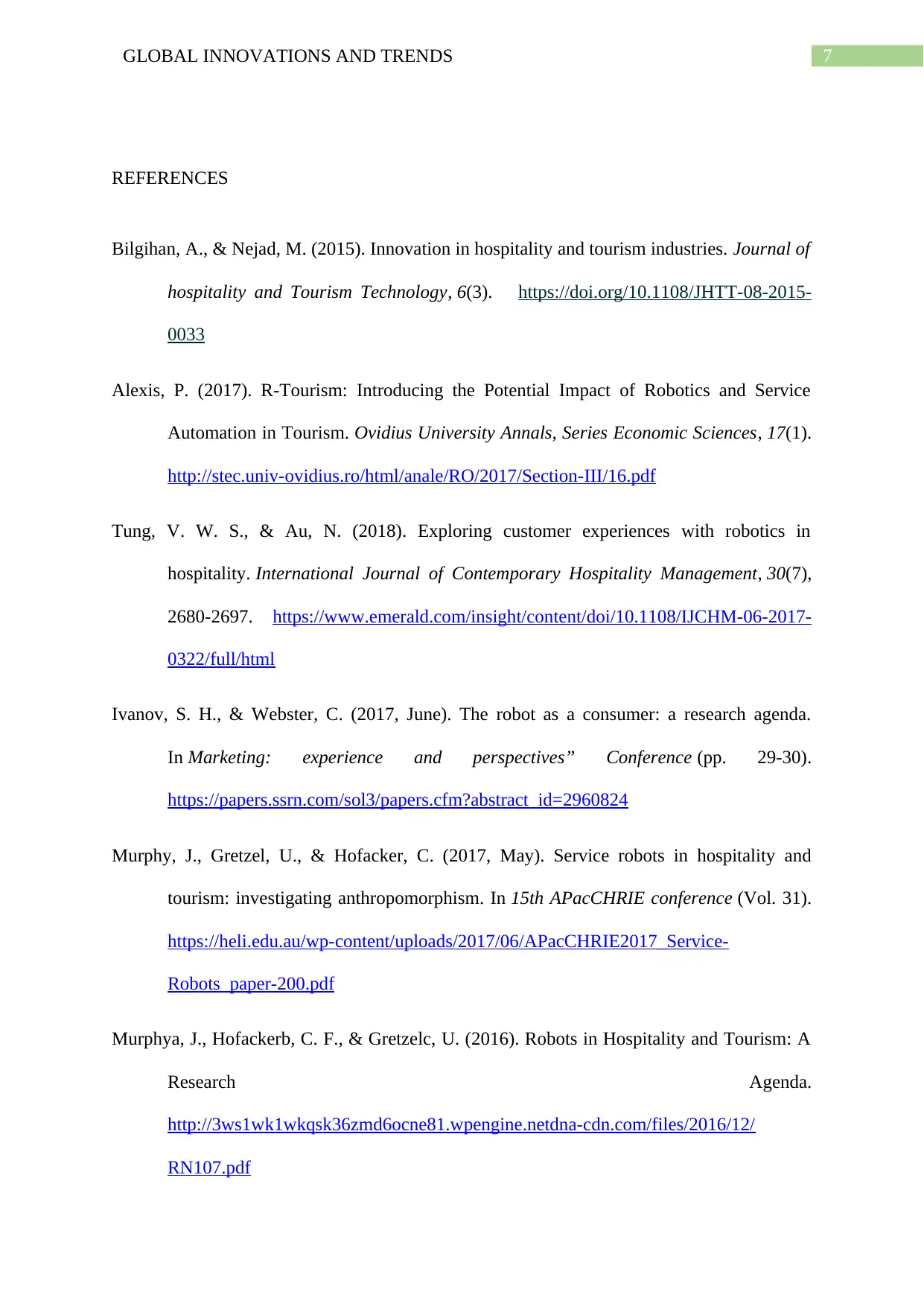
7GLOBAL INNOVATIONS AND TRENDS
REFERENCES
Bilgihan, A., & Nejad, M. (2015). Innovation in hospitality and tourism industries. Journal of
hospitality and Tourism Technology, 6(3). https://doi.org/10.1108/JHTT-08-2015-
0033
Alexis, P. (2017). R-Tourism: Introducing the Potential Impact of Robotics and Service
Automation in Tourism. Ovidius University Annals, Series Economic Sciences, 17(1).
http://stec.univ-ovidius.ro/html/anale/RO/2017/Section-III/16.pdf
Tung, V. W. S., & Au, N. (2018). Exploring customer experiences with robotics in
hospitality. International Journal of Contemporary Hospitality Management, 30(7),
2680-2697. https://www.emerald.com/insight/content/doi/10.1108/IJCHM-06-2017-
0322/full/html
Ivanov, S. H., & Webster, C. (2017, June). The robot as a consumer: a research agenda.
In Marketing: experience and perspectives” Conference (pp. 29-30).
https://papers.ssrn.com/sol3/papers.cfm?abstract_id=2960824
Murphy, J., Gretzel, U., & Hofacker, C. (2017, May). Service robots in hospitality and
tourism: investigating anthropomorphism. In 15th APacCHRIE conference (Vol. 31).
https://heli.edu.au/wp-content/uploads/2017/06/APacCHRIE2017_Service-
Robots_paper-200.pdf
Murphya, J., Hofackerb, C. F., & Gretzelc, U. (2016). Robots in Hospitality and Tourism: A
Research Agenda.
http://3ws1wk1wkqsk36zmd6ocne81.wpengine.netdna-cdn.com/files/2016/12/
RN107.pdf
REFERENCES
Bilgihan, A., & Nejad, M. (2015). Innovation in hospitality and tourism industries. Journal of
hospitality and Tourism Technology, 6(3). https://doi.org/10.1108/JHTT-08-2015-
0033
Alexis, P. (2017). R-Tourism: Introducing the Potential Impact of Robotics and Service
Automation in Tourism. Ovidius University Annals, Series Economic Sciences, 17(1).
http://stec.univ-ovidius.ro/html/anale/RO/2017/Section-III/16.pdf
Tung, V. W. S., & Au, N. (2018). Exploring customer experiences with robotics in
hospitality. International Journal of Contemporary Hospitality Management, 30(7),
2680-2697. https://www.emerald.com/insight/content/doi/10.1108/IJCHM-06-2017-
0322/full/html
Ivanov, S. H., & Webster, C. (2017, June). The robot as a consumer: a research agenda.
In Marketing: experience and perspectives” Conference (pp. 29-30).
https://papers.ssrn.com/sol3/papers.cfm?abstract_id=2960824
Murphy, J., Gretzel, U., & Hofacker, C. (2017, May). Service robots in hospitality and
tourism: investigating anthropomorphism. In 15th APacCHRIE conference (Vol. 31).
https://heli.edu.au/wp-content/uploads/2017/06/APacCHRIE2017_Service-
Robots_paper-200.pdf
Murphya, J., Hofackerb, C. F., & Gretzelc, U. (2016). Robots in Hospitality and Tourism: A
Research Agenda.
http://3ws1wk1wkqsk36zmd6ocne81.wpengine.netdna-cdn.com/files/2016/12/
RN107.pdf

8GLOBAL INNOVATIONS AND TRENDS
Bowen, J., & Morosan, C. (2018). Beware hospitality industry: the robots are
coming. Worldwide Hospitality and Tourism Themes, 10(6), 726-733.
https://www.emerald.com/insight/content/doi/10.1108/WHATT-07-2018-0045/full/
html
Papathanassis, A. (2017). Cruise tourism management: State of the art. Tourism
Review, 72(1), 104-119. https://www.emerald.com/insight/content/doi/10.1108/TR-
01-2017-0003/full/html
Pritchard, A. (2018). Predicting the next decade of tourism gender research. Tourism
management perspectives, 25, 144-146. https://doi.org/10.1016/j.tmp.2017.11.014
Hsu, C. H. (2018). Tourism education on and beyond the horizon. Tourism management
perspectives, 25, 181-183. https://doi.org/10.1016/j.tmp.2017.11.022
Kvach, Y., Koval, V., & Hrymaliuk, A. (2018). Tourism and hospitality industry in the
context of global economic development. Економіка. Екологія. Соціум, 2(4), 11-21.
https://ees-journal.com/index.php/journal/article/view/81
Zsarnoczky, M. (2018). The Digital Future of the Tourism & Hospitality Industry. Boston
Hospitality Review, 6. http://www.bu.edu/bhr/files/2018/06/The-Digital-Future-of-
the-Tourism-and-Hospitality-Industry.pdf
Peláez, A. L., & Sánchez-Cabezudo, S. S. (2014). From “Singularity” to Inequality:
Perspectives on the Emerging Robotics Divide. In The Robotics Divide (pp. 195-217).
Springer, London. https://link.springer.com/chapter/10.1007/978-1-4471-5358-0_11
Tüzünkan, D. (2017). The Relationship between Innovation and Tourism: The Case of Smart
Tourism. International Journal of Applied Engineering Research, 12(23), 13861-
Bowen, J., & Morosan, C. (2018). Beware hospitality industry: the robots are
coming. Worldwide Hospitality and Tourism Themes, 10(6), 726-733.
https://www.emerald.com/insight/content/doi/10.1108/WHATT-07-2018-0045/full/
html
Papathanassis, A. (2017). Cruise tourism management: State of the art. Tourism
Review, 72(1), 104-119. https://www.emerald.com/insight/content/doi/10.1108/TR-
01-2017-0003/full/html
Pritchard, A. (2018). Predicting the next decade of tourism gender research. Tourism
management perspectives, 25, 144-146. https://doi.org/10.1016/j.tmp.2017.11.014
Hsu, C. H. (2018). Tourism education on and beyond the horizon. Tourism management
perspectives, 25, 181-183. https://doi.org/10.1016/j.tmp.2017.11.022
Kvach, Y., Koval, V., & Hrymaliuk, A. (2018). Tourism and hospitality industry in the
context of global economic development. Економіка. Екологія. Соціум, 2(4), 11-21.
https://ees-journal.com/index.php/journal/article/view/81
Zsarnoczky, M. (2018). The Digital Future of the Tourism & Hospitality Industry. Boston
Hospitality Review, 6. http://www.bu.edu/bhr/files/2018/06/The-Digital-Future-of-
the-Tourism-and-Hospitality-Industry.pdf
Peláez, A. L., & Sánchez-Cabezudo, S. S. (2014). From “Singularity” to Inequality:
Perspectives on the Emerging Robotics Divide. In The Robotics Divide (pp. 195-217).
Springer, London. https://link.springer.com/chapter/10.1007/978-1-4471-5358-0_11
Tüzünkan, D. (2017). The Relationship between Innovation and Tourism: The Case of Smart
Tourism. International Journal of Applied Engineering Research, 12(23), 13861-
⊘ This is a preview!⊘
Do you want full access?
Subscribe today to unlock all pages.

Trusted by 1+ million students worldwide

9GLOBAL INNOVATIONS AND TRENDS
13867.
https://www.researchgate.net/profile/Demet_Tuzunkan/publication/321906089_The_
Relationship_between_Innovation_and_Tourism_The_Case_of_Smart_Tourism/
links/5a38e6530f7e9b7c48700c5b/The-Relationship-between-Innovation-and-
Tourism-The-Case-of-Smart-Tourism.pdf
13867.
https://www.researchgate.net/profile/Demet_Tuzunkan/publication/321906089_The_
Relationship_between_Innovation_and_Tourism_The_Case_of_Smart_Tourism/
links/5a38e6530f7e9b7c48700c5b/The-Relationship-between-Innovation-and-
Tourism-The-Case-of-Smart-Tourism.pdf
1 out of 10
Related Documents
Your All-in-One AI-Powered Toolkit for Academic Success.
+13062052269
info@desklib.com
Available 24*7 on WhatsApp / Email
![[object Object]](/_next/static/media/star-bottom.7253800d.svg)
Unlock your academic potential
Copyright © 2020–2025 A2Z Services. All Rights Reserved. Developed and managed by ZUCOL.





